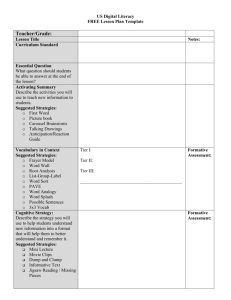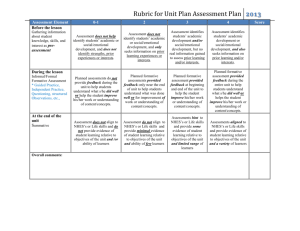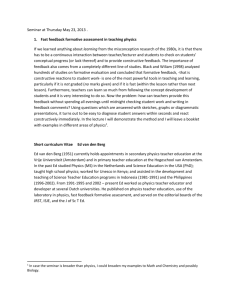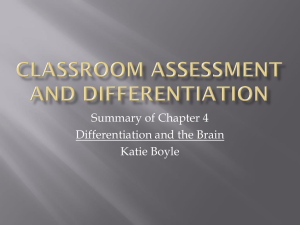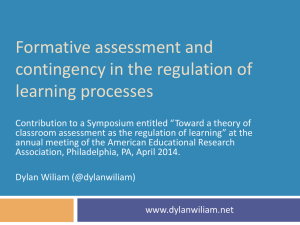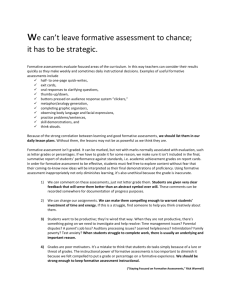The Power and Importance of Formative Assessment
advertisement
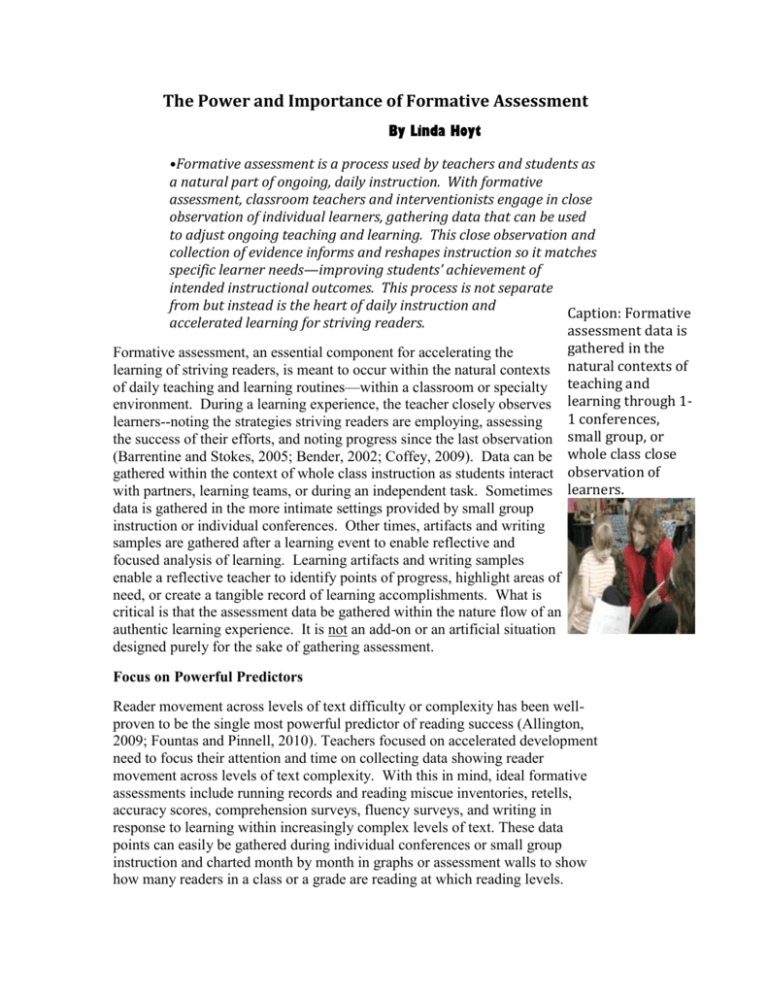
The Power and Importance of Formative Assessment By Linda Hoyt •Formative assessment is a process used by teachers and students as a natural part of ongoing, daily instruction. With formative assessment, classroom teachers and interventionists engage in close observation of individual learners, gathering data that can be used to adjust ongoing teaching and learning. This close observation and collection of evidence informs and reshapes instruction so it matches specific learner needs—improving students’ achievement of intended instructional outcomes. This process is not separate from but instead is the heart of daily instruction and Caption: Formative accelerated learning for striving readers. assessment data is gathered in the Formative assessment, an essential component for accelerating the learning of striving readers, is meant to occur within the natural contexts natural contexts of of daily teaching and learning routines—within a classroom or specialty teaching and environment. During a learning experience, the teacher closely observes learning through 11 conferences, learners--noting the strategies striving readers are employing, assessing the success of their efforts, and noting progress since the last observation small group, or (Barrentine and Stokes, 2005; Bender, 2002; Coffey, 2009). Data can be whole class close gathered within the context of whole class instruction as students interact observation of with partners, learning teams, or during an independent task. Sometimes learners. data is gathered in the more intimate settings provided by small group instruction or individual conferences. Other times, artifacts and writing samples are gathered after a learning event to enable reflective and focused analysis of learning. Learning artifacts and writing samples enable a reflective teacher to identify points of progress, highlight areas of need, or create a tangible record of learning accomplishments. What is critical is that the assessment data be gathered within the nature flow of an authentic learning experience. It is not an add-on or an artificial situation designed purely for the sake of gathering assessment. Focus on Powerful Predictors Reader movement across levels of text difficulty or complexity has been wellproven to be the single most powerful predictor of reading success (Allington, 2009; Fountas and Pinnell, 2010). Teachers focused on accelerated development need to focus their attention and time on collecting data showing reader movement across levels of text complexity. With this in mind, ideal formative assessments include running records and reading miscue inventories, retells, accuracy scores, comprehension surveys, fluency surveys, and writing in response to learning within increasingly complex levels of text. These data points can easily be gathered during individual conferences or small group instruction and charted month by month in graphs or assessment walls to show how many readers in a class or a grade are reading at which reading levels. When this kind of data is closely monitored in combination with month by month targets for each class and/or grade, teachers become more aware of which students are at-risk of not meeting end of year targets and can flow additional resources and support to learners who may need a burst to fulfill their grade level expectations. Common Formative Assessments For common formative assessments that allow comparisons across groups of learners, across classrooms, and even across grades, teachers can develop inquiry questions that guide and shape use of the data they have collected (Wiggins, 2010, DuFours, 2007). Example 1: A Written Response to Learning After a read aloud, students may be asked to write about the author’s purpose in the selection. Writing samples are collected and teachers analyze the writing samples using common inquiry questions (based on Common Core State Standards) such as: How many students correctly identified the author’s purpose? How many students formatted their response with a main idea, a gist statement and a conclusion? How many students used at least one complex sentence in the response? These common and “formative” assessment questions utilize instructional products that are a completely natural and responsible artifact of the learning—taking no time away from instruction and keeping learners focused on the important standards of “author purpose, gist statements and conclusions, and complex sentences.” Data can be charted by class, by grade, or in any number of ways that make close observation quantifiable. This is formative assessment that allows tracking of progress over time and across populations of learners. (No teacher time is spent on the construction of artificial questions or tasks that consume valuable instructional time, and teacher analysis can easily be linked directly to next steps in instruction.) Example 2: Using Observational Data such as Running Records, Reading Miscue Inventories, Comprehension Rubrics, Strategy Scoring Guide As a natural part of reading conferences and small group instruction a teacher listens to learners read and then retell or summarize a selection. Common questions that could surround the data could include: How many students were able to maintain 90% accuracy and move up a reading level in the last two weeks? How many students were able to maintain adequate comprehension with a retell or comprehension survey score of ___ and move up a reading level within the last two weeks? Which strategies are used most by students who moved up a level within the last two weeks: look at the pictures, substitute a synonym for an unknown word, use beginning and ending sounds, or backtrack and reread? Protect the Focus on Ongoing Instruction Well-meaning educators are sometimes misled into thinking that common formative assessments must be separate from daily instruction. This is not the case. What is important is that common formative assessments are part of the natural flow of daily instruction and are analyzed through the window of teacher-developed questions that highlight and draw attention to the behaviors that most influence achievement. Questions that are designed to replicate a testing format and delivered to students for the sole purpose of assessment are no longer “formative assessments.” These synthetic assessments take time away from instruction cannot be labeled as formative. Gather Data on the Full Spectrum of Literacy Behaviors It is vital that opportunities for data gathering and close observation offer information about the full spectrum of behaviors that comprise effective, thoughtful reading. Focusing on a single subsystem of literacy such as fluency, word study, or micro-sets of comprehension strategies can offer a dangerously limited view of reader development and could limit a striving readers’ ability to achieve the complex literacies that are demanded by future schooling and the workplace. Anecdotal notes, work samples, rubrics, checklists, and selfreflections work together to offer a broad-based view of learner development and empower classroom teachers and interventionists to make the best possible decisions about instruction. Careful planning is needed to ensure that formative data collection samples from each of these areas. Focus on Instruction Close observation and formative assessments guide teacher decision-making and instructional planning so instruction and learner need are inextricably tied together. This places observable behaviors as the driving force in teacher decision-making, coaching, and lesson planning—guiding teachers who observe closely to design instruction with the greatest potential of lifting learner performance. Close observation of individuals as they operate within a range of grouping patterns and learning contexts is essential to responsive lesson design and accelerated achievement (Duke and Pearson, 2002; Wiggins, 2010). Best of all, common questions that are based on the essential interactions that occur naturally within readers workshop or writers workshop preserve and protect precious instructional time while providing formative data that can inform and shape instruction. There is no program that can engage in close observation as a striving learner navigates a leveled reading selection. There is no standardized test that can analyze the phonic knowledge that is applied as an emergent writer laboriously constructs a written sentence. There is no outside force that can substitute for a teacher who listens closely as a language learner applies academic vocabulary and engages in a peer conversation. There is no teacher made “test item” that can measure up to the real-time learning that can be observed and documented through formative assessment. It is the teacher’s ability to closely observe, notice nuances in learning behavior, and then respond with instruction that is targeted to learner need that separates teachers who make exceptional progress with striving students from those who do not. (Marzano, 2006) With formative assessment, every instructional moment provides opportunity for close observation of students. Opportunities to: •observe how well striving readers are attending to and applying demonstrated strategies. •notice and record reading behaviors that help striving readers attain meaning or to unlock word parts. •attend to patterns in reader development and think toward next steps in instruction. •record expansion of oral language or integrated use of academic vocabulary. •document a striving reader’s ability to reflect on content and offer critical, analytical reflections •analyze writing samples for evidence of content understanding, sentence structure, grammar use, and word choice. •plan for next steps in instruction

